Meet 6 law firm leaders, each with a different story, each at the top of her game

Photo of Madeline Cahill-Boley by Sal Owen.
Reporters’ phone calls steadily interrupted Madeline Cahill-Boley’s first days as managing partner of midsize, San Diego-based law firm Sullivan Hill Lewin Rez & Engel in 2008. And while she knew it would be a topic broached during the interviews, Cahill-Boley wasn’t prepared for the surge of questions about her gender.
Forget about plans for her firm’s future. “What is it like to be a woman in charge?” they all wanted to know.
The subject of women in leadership may not be new, but it’s hard to think of a time when it was hotter than today. From Princeton University professor Anne-Marie Slaughter, author of the widely discussed Atlantic article “Why Women Still Can’t Have It All,” to Sheryl Sandberg, Facebook COO and champion of the “lean in” movement, women who appear to “have it all” are branded heroes, fraudsters and inhuman cyborgs unburdened by mortal necessities like sleep.
The intensity of these debates is especially fiery in the legal profession. For while conditions for female lawyers at law firms have improved since Arabella Mansfield was granted admission to practice law in Iowa in 1869, droves of female law grads still steer clear of partner-track and leadership positions early in their careers. According to a NALP 2012 study, women constitute just under 20 percent of law firm partnership ranks—a number that shrivels in the top level of leadership. And it’s considerably worse for minority women, who make up only 2.16 percent of the nation’s law firm partners.

“You’re right, it’s few and far between,” is how Ngozi C. Okorafor, president of the Black Women Lawyers’ Association of Greater Chicago, puts it. “We were making many more inroads toward having minorities and a significant number of black women as associates in years past than now. The economy has forced large law firms to shed associates and partners and, in my view, a disproportionate number were minorities.”
For Nicole Auerbach, a former partner at Katten Muchin Rosenman who left to co-found Valorem Law Group in Chicago, the answer is simple. “Many women fear that if they do lean in, they will fall on their faces in the attempt,” Auerbach says. “When institutional barriers require many women to learn to lean in and leap to succeed, the path to the top is perceived as not inviting, rewarding or attainable.”
The six law firm leaders featured in this article appear to have learned to lean, leap and launch themselves to the highest echelons of law firm hierarchies. They represent that small number of women running midsize-to-major law firms in North America; and yet each of their stories is unique, underlining the truth that paths to the top do not follow the same map.
But there is one thing that all their stories share: a commitment by each woman to reach her goal of managing a law firm, and to not let obstacles stop her from achieving that goal.
We don’t know whether they have it all. We do know that they’re decision-makers and commanders. They sit in powerful positions and have voices on male-dominated boards, directing their companies.
They’re simultaneously good law firm citizens who’ve played by traditional law firm rules and attorneys who possess the brass to, say, go for partner four months before taking time off to deliver twin boys. And—like Sandberg, Slaughter and other powerful female figures—we’re fascinated by them and want to know their secrets.
We also know that their leadership presence is significant beyond personal tales of achievement because despite the positive effects of firm-sanctioned initiatives for female lawyers, true industry change comes when women possess “economic and institutional power” within the profession, says Patricia Gillette, a rainmaking partner at Orrick, Herrington & Sutcliffe in San Francisco whose book of business has exceeded $5 million for the past 15 years.
For these six female lawyers, their firms’ buck stops at their feet. And in a time when the professional feats of a successful woman are so rare they can make her appear superhuman, we’re relieved to learn that they can sometimes be found with bare feet discreetly hidden under their desks because, after a certain amount of time, stilettos kill.
Once you’ve reached the top, who’s looking at your shoes anyway? We’re more intrigued by their ability to turn a deaf ear to social pressures. To ascend the ranks without succumbing to self-inflicted guilt over where time is spent—at home or the office. To eschew outside distractions from top priorities, even as those fluctuate.
While each of the women interviewed is quick to state that her journey consisted of individual choices, they all acknowledge our keen interest in their careers—and the impact of their voices on the expectations of future generations.
“It worries me that the next generation of young women seem to think there is no going back, that these opportunities will always be there and the choices they make are personal to them and will not have any greater impact at all,” says partner Lori Duffy of the Toronto-based firm WeirFoulds, a past president of the Canadian Association of Women Executives and Entrepreneurs. “Women have the opportunities we have because we really fought hard for them, and if we stop ensuring that those opportunities continue and stop reminding everyone that they have to continue, they will be gone in a nanosecond.”
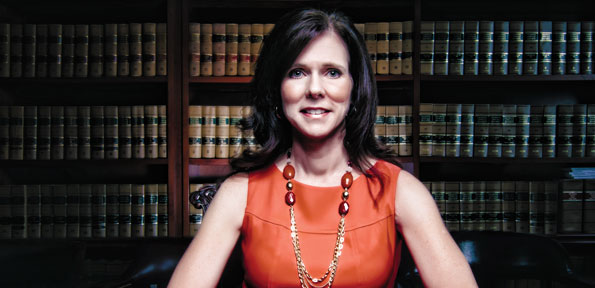
Photo of Kellye Moore by Ryan Gibson.
THE PLANNER
Kellye C. Moore, managing partner of Walker Hulbert Gray & Moore
It happens more often than she’d prefer, so Kellye C. Moore has perfected her response: “Managing partner,” she corrects in a polite-yet-firm Southern drawl whenever one of her male colleagues refers to her as the firm’s office manager.
A civil litigator with more than 20 years of experience, Moore, 44, was promoted to lead the tight-knit Perry, Ga.-based law firm Walker Hulbert Gray & Moore in 2011.
Deflecting the implicit bias in the irksome faux pas, Moore knows her value to the firm. That is why the California-born daughter of a U.S. Air Force colonel requested her name on the door and wrote her own compensation package before she agreed to become an equity partner and head of the firm of seven male lawyers, six of whom are related by blood.
“She watched what was happening at the time,” Chris Moore, a government engineer, says of his wife’s negotiation from associate attorney with significant managerial duties to managing partner.
“She’s never had to worry about having a place and a future at the firm; she’s been invaluable since they met her,” he says. “But they aren’t the type of firm to have a plan for her. She had to come up with that plan herself.”
While Moore’s career plans have always veered from the typical status quo of hour-logging office associate to fee-sharing partner, she’s proven her ability to ingratiate herself with the lawyers and clients of her small-town firm with a dogged work ethic, and she cemented her worth with subtle muscle.
She accepted her first contract assignment in 1994 (a year after graduating from Mercer University School of Law), stopping by the firm every morning to gather files and work. She then completed the work at home with her newborn daughter nearby and returned it to the office the following day. As her children grew, so did Moore’s presence in the office—to weekday mornings, followed by regular school hours and then eventual, steadier full-time hours. She also transitioned from independent counsel to firm staff attorney, always gravitating toward the most complex matters. “I knew where I wanted to be,” Moore says. “I had my own schedule for work-life balance. But I also knew where I wanted to go. It took 10 years until I was at the office every day, but I’ve always done the same amount of work. It just depended on whether I was getting it done there versus at home working evenings and weekends. Today, I do very little work at home and almost all of it here.”
As her litigation practice grew, Moore also assumed the role of legal technologist, pushing for updated software and client platforms and a stronger Web presence to boost the firm’s efficiency and bottom line.
“She’s been one of the driving forces in the law firm to keep us on top of the dramatic changes the whole law practice has seen in the last 10 to 15 years,” says firm founder Lawrence C. Walker Jr.
Moore is highly attuned to change inside the firm, too. When a new partner who had done some of the less glamorous, day-to-day business tasks such as payroll moved in-house, she asked to take on those duties as a senior associate. By 2006 Moore was overseeing most of the firm’s managerial duties.
Partnership came five years later, on her own terms, because of her intimate knowledge of the firm’s inner workings and the commitment she’d demonstrated for 20 years.
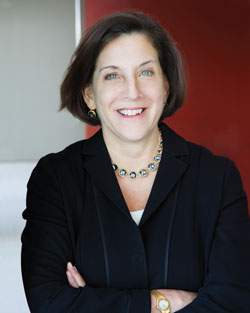
Photo of Kim Koopersmith by Len Irish.
GOOD FIRM CITIZEN
Kim Koopersmith, chairperson of Akin Gump Strauss Hauer & Feld
High school friends of Kim Koopersmith’s daughters knew to never call during dinner—often served at 9:30 p.m. Unorthodox timing for some, the children knew that their mother’s cooking—especially her rib-eye steak and potato galette—was always worth the wait, along with valued time with their lawyer parents.
“My friends thought it was a strange family quirk, but they got used to it, and we did too,” says Koopersmith’s oldest daughter Meredith, 25, now a U.S. District Court law clerk. “I don’t know that she could have accomplished it all if she were home at 5 o’clock. And growing up as a young girl you detect, ‘Oh, my mom has a career she finds fulfilling.’ I was very proud of her.”
For Koopersmith, 53, “it all” includes having been the New York City-based U.S. managing partner of Akin Gump Strauss Hauer & Feld, and her appointment in April as the firm’s global chair.
Although she governs more than 800 attorneys at the AmLaw Top 50 firm, Koopersmith laughs recalling a conversation when, as she progressively assumed greater management duties, a colleague suggested she could one day run the firm. “In law school, I wanted to be a public interest lawyer,” she says. “But as I became more senior at the firm, that thought [of managing Akin Gump] stayed in the back of my mind.
“I found that I had an intuitive sense of how an organization runs and how to add value to it. I worked hard to make sure that the law firm could find something about my contribution that was distinct both as a lawyer and in terms of advancing the agenda of the firm.”
After practicing for a decade at a midsize New York City law firm, Koopersmith accomplished both feats at Akin Gump, initially as a part-time partner for two years on a four-day workweek.
“Kim picked that particular point in her career to take part-time status to tend to two quite young children, with some concern that it would affect her career,” says Bruce McLean, the firm’s former chairman. “She took a bold move to do that in the context of BigLaw, where a lot of women believe they can’t make it work and frequently get those signs from their firms. I’d like to think that back then we were unusual [in] that it didn’t affect her career.”
Koopersmith sees herself as a “good firm citizen.”
“I don’t think you can completely rewrite the rules,” she says. “The expectations on being a lawyer at a large law firm are high. You need to be wanting to put in the kind of effort and make the kind of commitment that that requires. Within the context, there are a lot of different ways that you can do some of the things you do in terms of making it manageable in your professional life and your life outside of work.”
Upon her successful move back to full-time status with a significant role for a large media company (an anomaly at the time), Koopersmith was appointed to construct and implement a new reduced-workload policy at the firm. Though she declines to name the client, she says, “This was a high-stakes case that threatened to have a substantial impact not simply on their business, but on their entire business model.”
While she acknowledges the benefits of a flexible work schedule, it was the valued relationship she developed with her client at the time of her transition and the opportunity to be well-positioned to return to litigate the media company’s case that abetted her rise up the managerial ranks.
“The single biggest way in which women can assist other women is focusing on how assignments are given out by their law firm at the younger levels,” Koopersmith says. “The thing that positions women to be most likely to succeed in a law firm is to have really good opportunities to shine. To shine you need to work on the cases and deals that are getting the spotlight.”
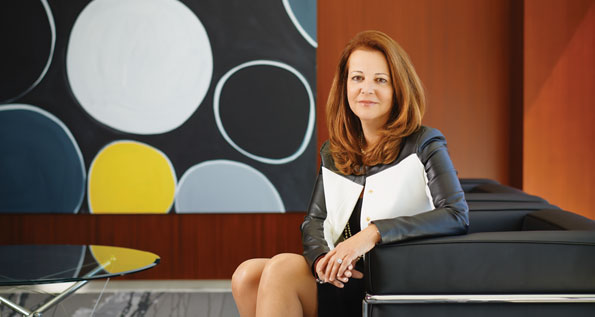
Photo of Lisa Borsook by Matthew Plexman.
DOING IT DIFFERENT
Lisa A. Borsook, executive partner at WeirFoulds
When Lisa A. Borsook was promoted to managing partner of her Toronto-based law firm, a senior litigator offered some words of guidance to her fellow female lawyers: The reason Borsook was so successful, he said, was because she practiced law like a man.
“He told us we could all take a lesson in that,” says Borsook’s longtime colleague Lori Duffy, a partner at WeirFoulds.
Manly or not, Borsook’s approach to her career differed from that of many of her female peers in the firm, says Duffy of her colleague, who became executive partner this January. It’s a role she created for herself.
At 16, Borsook took the LSAT and was admitted to the University of Toronto’s law school in the fall of her sophomore year in college. She joined WeirFoulds at age 21 and eschewed litigation, her first choice, to pursue a corporate practice at the suggestion of her husband on the premise that trial work would consume too much time away from home.
Although her marriage was short-lived, Borsook’s career flourished when she became a firm partner at 26.
Her “ambition gene” really kicked in around 30, she says, incited in part by her physician grandmother and lawyer mother. She focused intently on building a lucrative commercial leasing practice, a tactic rewarded with appointments to the firm’s more senior management committees.
“There’s an intimate connection between being a good revenue generator for the firm and being asked to take management positions,” says Borsook, 53.
The strength of Borsook’s practice put her in a position of power compared to other female partners who seek senior roles at earlier stages in their careers, Duffy adds. Borsook’s success also affected her perspective on the conflict of work-life balance.
“Because this all came to me so young, when I did remarry and have kids,” Borsook says, “I was confronting life issues that some women feel at a different stage in [their careers].
“I was already a partner and I’d be damned if I was going to give up the maturation of my practice.”
This time Borsook’s husband was also an attorney with a vibrant and demanding practice. Expectations of dinner at 6 o’clock and other tasks often thrust upon wives at home didn’t exist.
One afternoon many years ago, Borsook recalls, she watched a sitter spend 45 minutes preparing a snack for her young boys. Had she been in charge, snacks would have been distributed within minutes and homework promptly attended to, she says.
However, she recognized the importance of that downtime for her kids, and she knew that her career offered the opportunity to provide the style of child care they needed—she could afford top-notch educations and have the opportunities to pass on the achievement-driven lessons she’d learned from the women in her family.
Cognizant of her accomplishments, Borsook was still unprepared for the waves of press coverage when she was tapped as managing partner in 2006. That spurred her to overhaul policies that hindered the advancement of other women, including a disproportionate emphasis on billable hours.
“If a lawyer’s value to the firm is time—only the number of hours they clock times their rate—attrition is inevitable, especially among women,” she says, acknowledging that many of the women at her firm also bear the brunt of housekeeping. “We now reward generating work and passing it to others.”
After six years of leadership, and eager to again devote more time to the practice she enjoys, Borsook resigned as managing partner and proposed a new role of executive partner, a complementary top-leadership position that allows Borsook to forgo overseeing all of the day-to-day firm operations and focus her management duties exclusively on client relationships and business development for the firm’s lawyers. Once again, she did things differently, this time from every man who’d led before.
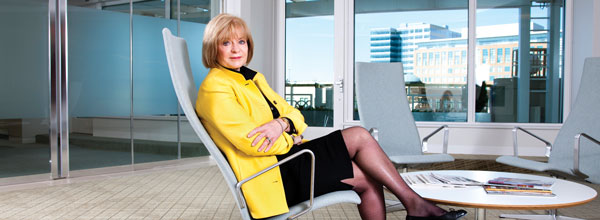
Photo of Anastasia Kelly by Stacy Zarin Goldberg.
“IT’S ALL LIFE”
Anastasia D. Kelly, co-managing partner for the Americas at DLA Piper
“I am what I am. If they see it, they see it. If they don’t, they don’t.”
With those words, Anastasia D. Kelly tossed her hat into the partnership ring at her BigLaw firm. At 39, Kelly—known as Stasia—was about to become a first-time mother, pregnant with twin boys and on five months’ bed rest (during a time before technology allowed telecommuting). Some colleagues thought she was crazy to risk the odds and others suggested she wait one more year.
“I knew that if I didn’t make partner, there was life outside of the firm,” says Kelly, now 63 and co-managing partner at megafirm DLA Piper. “But if I stepped back from going for it, I knew I would die.”
Kelly’s colleagues offered her partnership that October, seven years into her practice at two major law firms. What they did not know was that Kelly and her husband had spent the prior evening with two babies recovering from allergic reactions to vaccines.
“All of the partners came to my house cheering with champagne and I’d totally forgotten that the vote had happened,” Kelly says. “When we talk about work-life balance, it’s all life. It’s doing what you do at certain points in your life because those are your priorities. And that’s where you figure out your balance.”
The daughter of a Boston cop and the first in her family to attend college, Kelly worked for five years in a corporate legal department before enrolling in a night program at George Washington University Law School, giving her a unique perspective of male-female dynamics in the business world.
“One thing women lawyers don’t do as much of as they should is ask male colleagues for help,” Kelly says. “We’re so focused on getting ahead as women, but I take that team concept to heart.”
After a brief stint at a midsize firm in Dallas, Kelly spent the next 10 years in Washington, D.C., at white-shoe firm Wilmer Cutler Pickering Hale and Dorr, where her collaboration-directed corporate background once again influenced the style of her practice.
“Wilmer is an old-line appellate law firm, and to focus on business development wasn’t in their comfort zone at the time,” Kelly says. “I’m an extrovert and I love to do that, so I took the opportunity to say, ‘We should be going out, speaking and meeting people, and talking to our clients.’ I started to do that and build a nice practice in white-collar and financial institutions.”
Five years into her partnership, Kelly received a call from a headhunter with an opportunity that launched the next phase of her career. She moved in-house as general counsel of Fannie Mae, spurred by the chance to showcase her managerial and team-building skill-set—a dynamic more rare in BigLaw. When a crippled and bankrupt Sears Corp. called, her husband and sons moved to Chicago to support “Mom’s excellent adventure,” one of many to come for the risk-defying Kelly. Bids to lead the complex bankruptcy and restructuring of WorldCom-MCI and AIG would follow.
“I’ve been in four different companies as GC,” Kelly says. “I was unafraid to take risks and had a supportive family willing to let me take them. Listening and seeing those opportunities is one way women can achieve success in a little bit of a nontraditional way.”
She also created and implemented DLA Piper’s Leadership Alliance for Women in 2006 as of counsel to the firm, training female lawyers how to generate business using networking tactics more often embraced by their male counterparts, such as business-social hybrid meetings on the golf course.
“Women are great at networking with each other and talking about the most intimate personal things, but for some reason they think it’s an imposition on friendships and relationships to talk about giving and getting business for each other,” says Kelly, recalling the disbelief expressed by a former female law firm colleague when Kelly would refer work to her as a general counsel.
Kelly returned to DLA as a partner in 2010 and was appointed to head the Americas offices in 2012, procuring business and cementing client relationships with the firm. Once again, an unexpected opportunity and a nontraditional leadership role.
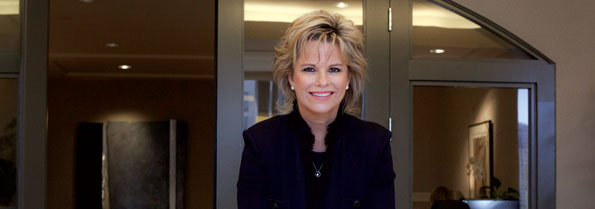
Photo of Madeline Cahill-Boley by Sal Owen.
HER GAME, HER RULES
Madeline Cahill-Boley, managing partner of Sullivan Hill Lewin Rez & Engel
At 11 years old, Madeline Cahill-Boley says, she airily told a judge—an acquaintance of her best friend’s father—that she’d see him in court one day as a lawyer, not as the administrative help he suggested a young girl interested in law should become.
When the good ol’ boy-style partnership of her former firm balked at the notion of a flexible schedule, she took her successful practice to a new firm while pregnant with her second child.
And when Cahill-Boley’s traditional three-year stint as chair of her firm’s executive committee came to an end, she didn’t step down. Instead, in her fifth year as managing partner of Sullivan Hill Lewin Rez & Engel, Cahill-Boley continues to redefine the traditional role of a law firm leader.
“When I switched firms I realized that the game they wanted to play wasn’t the game I did,” Cahill-Boley, 53, says of leaving Sullivan Hill, where she’d risen from a young associate to become the firm’s only female partner—and where she would later return to lead. “I found a firm that was playing the same game as me. I created a set of rules that I wanted to live by while raising children as a single mom.
“The problem is: We live in a binary-thought world, particularly as lawyers. Things are black or white, right or wrong. We don’t think in terms of creating a new game.”
Cahill-Boley’s attitude was forged as the young daughter of a single mother and later at Mills College, an Oakland, Calif., women-only liberal arts school chosen because there she’d “have a voice.”
After graduation, Cahill-Boley worked for an economic consulting firm in Los Angeles (to keep a promise made to a professor not to waste her life being a lawyer) before attending the University of California Hastings College of the Law in San Francisco.
Marriage, children and law firm partnership came within the next five years, followed by divorce, a California real estate recession and single motherhood. In response, Cahill-Boley diversified her practice, enlisted quality help at home and studied coursework on the mechanisms of people, relationships and the impact of fear on their choices and actions.
“The leadership track came from how I presented myself in the office, which was very different from the past,” Cahill-Boley says of her return to her San Diego firm after a five-year hiatus. “Qualitatively I was more present with my partners when we’d speak. I’d listen and focus on their concerns and understand their [motivations]; because we had a history, there was an opening to have those exchanges. I started to see possibilities in everything we’d talk about.
“The first part of my career, I realized that I’d become cynical, judgmental, afraid to speak or create a future I wanted to live in,” Cahill-Boley says. “Some people say we’re stuck inside these traditional roles, but we can change those in a moment’s notice. … Change can occur quickly, especially at midsize firms, if you can shine a light on the possibilities of a group of people who can work collaboratively together.”
Those possibilities include greater innovation and creativity in a profession that typically confines itself to the past. Technological advances and a generational shift will increase resistance to the billable hour as both a pricing mechanism and when evaluating lawyer performance, Cahill-Boley says. Greater collaboration among lawyers and a shift away from siloed practices will become the norm.
Cahill-Boley is “a master at relationships,” says Susan Hackett, CEO and chief legal officer of Legal Executive Leadership in Chevy Chase, Md. That skill binds her ability to counsel clients and lead her firm, Hackett says.
“This isn’t about being nice,” Hackett says. “This is about understanding that leadership is based on integrity and the willingness of others to follow because they think you’re interested and will listen to them and represent their interests and needs best.
“Leadership has changed in its definition at law firms. It’s no longer about being the most successful, even though Madeline has a successful practice. Lawyers are asking how to move forward, especially in chaos. They want a listener, not someone who says ‘shut up and follow.’ “That’s what Madeline brings to the table: the ability to lead and move a group of people forward to collaborate.”
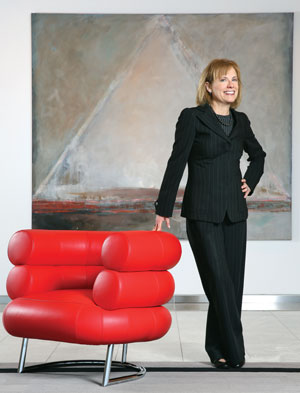
Photo of Susan Levy by Katrina Wittkamp
IN THE FOOTSTEPS
Susan C. Levy, managing partner of Jenner & Block
Although the first in her family to attend law school, when it came to selecting a law firm to work for, Susan C. Levy looked for a place where women before her had beaten back some of the brush, easing her trek to the top.
When the Harvard Law School graduate joined Jenner & Block in 1982, female lawyers already had a strong presence among the associate, partnership and management ranks—an anomaly among major national law firms today, and even more so 30 years ago.
“We were one of the relatively few firms with women in leadership positions and women who were business generators,” says Levy, 55, the Chicago-based managing partner of the nearly 500-lawyer firm. “The women leaders ahead of me—the mothers who went on maternity leave before I did—all helped me in my career because I never felt like I had to be a trailblazer.
“It’s hard enough to succeed at a major law firm, but I never felt that I had to prove myself because I was a woman or do anything different because I was a woman because there were a lot of women here. That was very helpful and, in retrospect, very important in my advancement.”
The mentorship of retired partner Joan M. Hall, a pioneer and legend among female lawyers, was particularly impactful. Early in Levy’s career, Hall hosted monthly luncheons for female associates and partners to teach them how to become rainmakers, knowing that those with big books dominate law firm management.
“I remember sitting there as a young associate and asking, ‘Why are we talking about business development? I just want to practice law,” Levy says. “But Joan saw, she was ahead of her time, because right now at every firm there’s a big focus on business development. And without a mentor, it’s difficult to navigate any firm.”
Under the tutelage of Hall and other mentors (male and female) Levy concentrated on sharpening her skills and growing her commercial litigation clientele. Although involved in some firm activities, her time was primarily devoted to her practice and her young family.
Levy made partner while pregnant with her son, and while she took maternity leave, she never stepped away from the full-time practice she loves—a feat she says was made possible by the 50/50 (not 60/40 or 70/30, she insists) co-parenting of her husband, Richard Levy, global chair of Latham & Watkins’ finance department.
As her children and her practice matured, Levy’s career entered a new phase.
“During my early years as a partner, I saw that in order to really thrive at the firm, it would be helpful to get more involved in management,” Levy says. “I was involved in firm committees, but ultimately I really wanted to be on the management committee,” an appointment position on one of the two top governing bodies of the firm. “I finally got up the nerve and walked into the office of the then-managing partner and asked to be put on the committee.”
A partner with 15 years of practice and significant client relationships under her belt, Levy didn’t know that she was already on his radar as a potential leader.
She was appointed and spent the next decade on the committee before her rise to managing partner in 2008—a role she still traces back to one nerve-wracking request.
“You’ve got to ask,” Levy says.
Sidebar

Photo of Molly Craig by Julia Lynn.
step aside, gentlemen—the ladies ARE LEADING
In 2013 women will lead five major professional organizations. What to make of this show of feminine force?
“It’s a testament to and a validation of the excellent quality of the generations of women before us,” says Molly H. Craig, a partner at the Hood Law Firm in Charleston, S.C., who’ll become president of the International Association of Defense Counsel in July. “I believe strongly it’ll energize the women behind us. I certainly was energized by the women who came before me.”
It also represents a sort of coming of age. “It’s a signal that women have now been out of law school and in the practice for long enough to be reaching a series of leadership positions,” says Chilton Davis Varner, a partner at King & Spalding in Atlanta and president of the American College of Trial Lawyers.
There is, of course, a but—the number of women in firm leadership and equity partnership positions is stagnating and their pay is still below that of male peers.
“It means women are advancing, that they’re credible and competent, that they have business minds as well as practical legal minds, that they know how to run a board, and that they’re relationship builders—which we knew,” says ABA President Laurel G. Bellows, a principal in the Bellows Law Group in Chicago. “However, on its face, this doesn’t speak to what’s happening in the legal profession. Women have found the road to success in bar leadership, but not in inheriting large clients from baby boomers as they retire or in getting the benefit of succession planning in law firms or the support they need to get through their motherhood or elder-parent phase if they don’t have a work-at-home spouse.
“Do I want to celebrate?” asks Bellows. “Of course, but it’s like asking me to celebrate the fact that we just elected 20 female U.S. senators. Only newspapers would think that’s a really good thing.”
Women must push for more gains. “It’s up to women to find the opportunities that exist and powerful champions who can help them achieve their highest professional growth,” says Mary Massaron Ross, a partner at Plunkett Cooney in Bloomfield Hills, Mich., and president of the Defense Research Institute. “Those people are increasingly there—certainly much more so than 15, 20 or 30 years ago.”
Does that mean women have to lean in, as Facebook COO Sheryl Sandberg says?
“I’m a big leaner, and I’ve been doing it a long time,” says Mary Alice McLarty, founding partner at McLarty Pope in Dallas and president of the American Association for Justice. “When I was a young mother, I ran for public office and was the only Democrat elected in my county. That set everybody to talking. But when you get used to doing it, it gets easier.” –G.M. Filisko
Correction
Because of an editing error, the print and initial Web versions of the sidebar “Step Aside, Gentlemen—the Ladies Are Leading,” June, incorrectly stated that Mary Alice McLarty, president of the American Association for Justice, believes her organization to be challenged by a dearth of risk-taking women. McLarty was referring to a more general shortage of women who are trial attorneys, as well as trial attorneys who are willing to take financial risks.The ABA Journal regrets the error.
Write a letter to the editor, share a story tip or update, or report an error.



